You’ll achieve stunning metal polishing results by starting with thorough surface cleaning using warm water and detergent, then selecting appropriate compounds like tripoli for cutting and white bars for finishing. Progress through grits from 320 to 800, maintaining consistent pressure while monitoring heat buildup at 1600-1800 RPM. Clean between grit changes and finish with protective wax or sealant to prevent oxidation. Master these fundamentals and you’ll discover advanced techniques that transform ordinary metal into mirror-like perfection.
Essential Surface Preparation for Metal Polishing
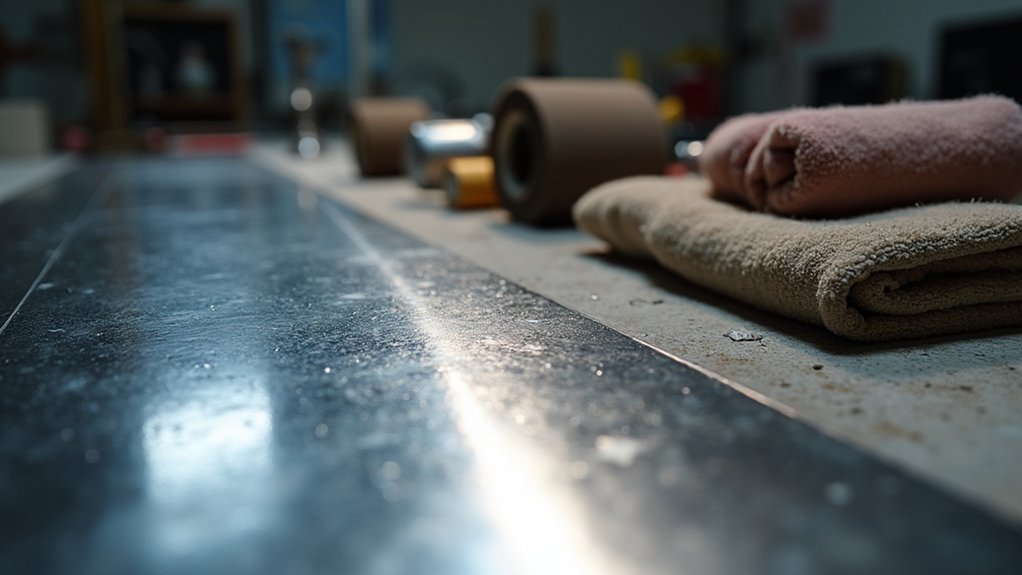
Before you can achieve a professional mirror finish, you must thoroughly clean your metal surface to remove every trace of rust, oil, grease, and debris that’ll interfere with the polishing process.
Use warm water, regular detergents, and a brush to scrub away all contaminants effectively. Once you’ve completed the initial cleaning, dry the surface completely with a clean rag to prevent water spots from forming.
If you’re dealing with stubborn residue or working with specific metal types, apply a specialized metal cleaner designed for your particular material.
Keep your workspace clean throughout preparation to avoid recontaminating the surface. For better visibility during sanding, mark sections with a compound bar to guarantee you achieve even coverage across the entire area.
Selecting the Right Polishing Compounds and Abrasives
You’ll achieve professional results by matching your compound selection to your desired finish level and metal type.
Different compounds like Pro40 and Pro25 offer varying degrees of cut and shine, while your abrasive choice determines how aggressively you’ll remove material from the surface.
Understanding these fundamentals helps you select the right combination for each specific polishing task.
Compound Types and Applications
When choosing polishing compounds for your metal projects, you’ll need to understand that each type serves a distinct role in transforming rough surfaces into mirror-like finishes.
Cutting compounds like tripoli and green bars tackle imperfections and scratches, effectively removing surface damage. Polishing compounds such as white and purple bars focus on enhancing shine and creating lustrous surfaces.
Your metal type determines compound selection – softer compounds work best with delicate metals, while harder compounds handle tougher materials effectively.
The Right Tools matter just as much as polishing compounds themselves. Pair sisal wheels with cutting compounds for aggressive material removal, and use loose cotton wheels with finishing compounds for that coveted high-gloss finish.
Always clean wheels between different compounds to prevent cross-contamination and maintain ideal results.
Abrasive Grit Selection Guide
Three critical factors determine your abrasive grit selection: the metal’s current condition, your desired finish level, and the severity of existing imperfections.
Start with coarser grits like 320 or 400 for initial surface preparation when dealing with significant damage. You’ll need lower grit numbers for more severe imperfections to effectively remove them.
Polish metal surfaces by progressively moving to finer grits such as 600 and 800 for smoother finishes.
Enhance your abrasive grit selection efficiency using compound bars like Tripoli or Pro40 for additional smoothing capabilities.
Hook and loop sanding discs with interface pads provide better cushioning and distribute consistent pressure evenly, improving finish quality.
Always clean surfaces with soft cloths like Pro50 between grit changes to prevent contamination and guarantee ideal results.
Mastering Hand and Machine Polishing Techniques
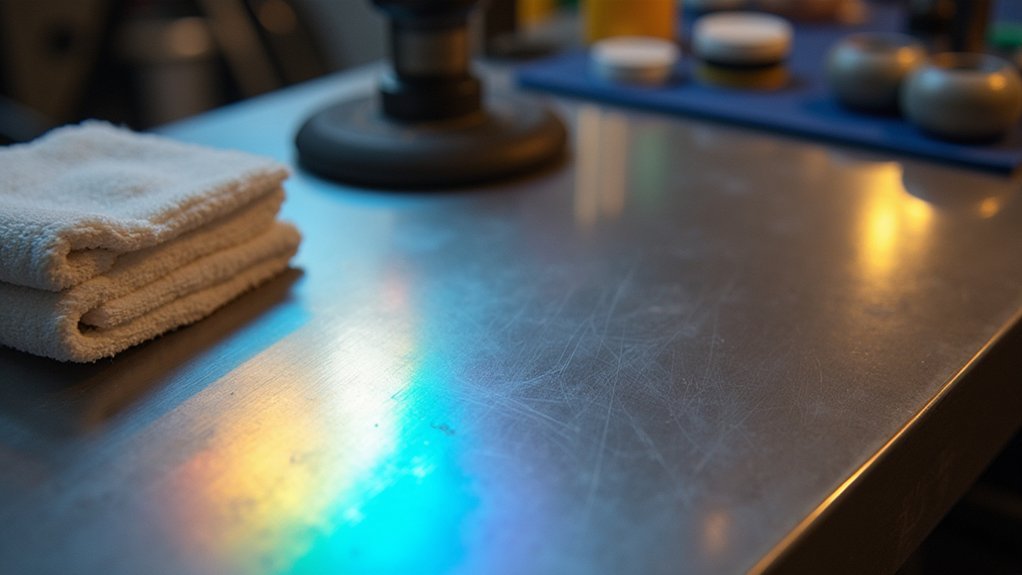
Although both hand and machine polishing have their place in metal finishing, understanding when to use each technique separates amateur results from professional-grade outcomes.
Hand polishing gives you precise control while maintaining the metal’s grain direction, making it ideal for detail work. For metal polishing larger surfaces efficiently, machine techniques excel at addressing defects quickly.
Use Zephyr Pro40 for aggressive cutting when hand polishing metal, then switch to Pro25 for finishing touches. Quality cloth like RockCar Roadie prevents scratching during the process.
When machine polishing, maintain 1600-1800 RPM with consistent pressure for uniform results. A Cotton Buffing Wheel enhances machine efficiency.
Combine both compounds—apply Pro40 before coloring, then finish with Pro25 for best shine.
Heat Management and Temperature Control Methods
You’ll need to master heat control to prevent surface damage and maintain professional results during metal polishing.
Managing friction buildup starts with finding the right RPM settings for your specific material and buffing compound combination.
Don’t skip cooling periods between passes—they’re essential for preserving your workpiece’s integrity and achieving that mirror-like finish you’re after.
Controlling Friction Heat Buildup
When polishing metal, friction heat buildup poses one of the greatest threats to achieving a flawless finish.
You’ll need to control this heat through strategic buffing techniques that protect your metal surface.
Start with airway buffing wheels that promote better airflow and reduce heat accumulation.
Maintain consistent angles with light pressure to minimize friction generation.
Here’s your heat control strategy:
- Use overlapping strokes to distribute pressure evenly and prevent localized hot spots
- Stop periodically to inspect your work and manage heat buildup before it becomes excessive
- Pause immediately when you detect excessive heat, allowing the metal to cool completely
These techniques prevent damage to both your finish and the underlying metal.
Optimal RPM Speed Settings
Since proper RPM selection directly impacts heat generation, you must match your buffing wheel speed to your specific polishing stage. For cutting processes, set your ideal rpm speed settings between 3200 to 3400 RPM to achieve effective material removal.
When finishing, reduce speeds to 1600-1800 RPM to prevent heat buildup while maintaining quality results.
Consistency in RPMs guarantees uniform polishing throughout your buffing process, reducing overheating risks that can damage metal surfaces. Monitor your workpiece temperature constantly – if it feels excessively hot, immediately lower your RPM or pause for cooling breaks.
Consider using airway buffing wheels to improve airflow and reduce friction-generated heat. Additionally, apply lighter pressure during buffing to minimize heat generation while achieving smoother finishes without compromising polish quality.
Cooling Between Buffing Passes
Although heat buildup poses one of the greatest threats to achieving professional polishing results, implementing strategic cooling between buffing passes will protect your metal from warping, discoloration, and surface damage.
You’ll need to monitor the temperature constantly, especially when working with softer metals like aluminum that heat up quickly.
Essential cooling techniques include:
- Use overlapping strokes with light pressure to minimize friction and heat generation during each pass
- Allow adequate cooling time after aggressive cut buffing before proceeding to finer grits
- Stop periodically to inspect your work and let hot surfaces cool to touch temperature
Employ airway buffing wheels that enhance airflow around your clean metal surface.
This approach guarantees consistent results while preventing overheating that compromises your finish quality.
Progressive Grit Systems for Superior Results
While many metalworkers rush through polishing with random grits, you’ll achieve superior results by implementing a systematic progressive grit system.
Start with 320 grit to remove surface imperfections, then methodically advance through 400, 600, and finally 800 grit for ideal finishing.
Overlap each pass by at least 50% to guarantee complete coverage and prevent missed spots. Clean the surface thoroughly between each grit stage using a soft cloth to remove dust and debris that could contaminate your work.
Choose your tools strategically: use a rotary sander for efficient imperfection removal during coarser stages, then switch to a dual-action sander for uniform finishing.
Monitor your progress continuously to determine the perfect moment for shifting to finer grits, assuring good results throughout the polishing process.
Protective Finishing and Long-Term Maintenance
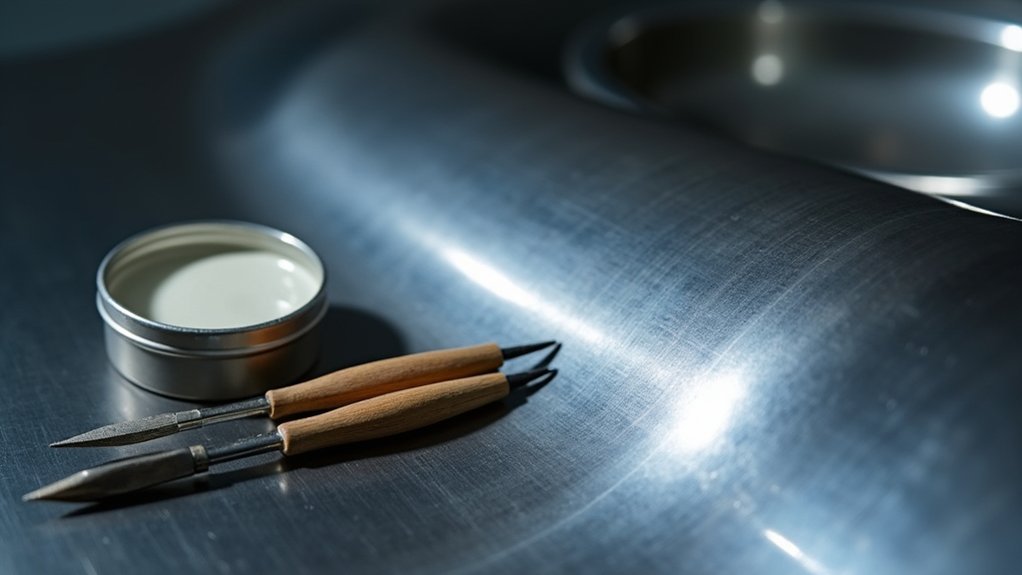
Once you’ve achieved that mirror-like finish through progressive grit polishing, protecting your investment becomes essential for maintaining long-term results.
Applying protective wax or sealant immediately after polishing prevents oxidation and corrosion while considerably extending your finish’s longevity.
For ideal preservation of polished metals, follow these critical steps:
- Seal with quality products – Use clear lacquer or metal wax to create an environmental barrier
- Clean gently and consistently – Employ soft cloths and non-abrasive cleaners to prevent scratches
- Avoid harsh chemicals – Stick to mild cleaning solutions that won’t damage the protective coating
Regular maintenance doesn’t require intensive effort.
Simply wipe surfaces with quality cloths and reapply protective treatments periodically. This approach respects your finish’s integrity while keeping metals looking pristine for years.
Frequently Asked Questions
What Is the Secret to Metal Polishing?
You’ll achieve stunning metal polishing results by thoroughly cleaning surfaces first, using proper compounds for each metal type, maintaining consistent overlapping technique, employing rotary tools, and protecting finished surfaces with appropriate sealers.
What Are the Tips for Metal Polishing?
Clean thoroughly with warm soapy water first. Progress through grits 320-800 systematically. Apply compound sparingly on small sections. Choose appropriate tools for your metal type. Always seal with wax or lacquer afterward.
What Is the Best Speed for Polishing Metal?
You’ll want to use 3200-3400 RPM for initial cutting to remove imperfections, then reduce to 1600-1800 RPM for final polishing. This prevents overheating while achieving that perfect high-gloss finish you’re after.
What Is the Best Thing to Shine Metal?
You’ll get the best results with specialized polishes like Mothers Billet Creme for aluminum or Meguiars NXT Metal Polish. For chrome, use Turtle Wax Chrome Polish, and try Brasso for stainless steel surfaces.
In Summary
You’ve now mastered the fundamentals of professional metal polishing. By preparing surfaces properly, choosing the right compounds, and controlling heat, you’ll achieve stunning results every time. Don’t skip steps in your progressive grit system—patience pays off. Remember to apply protective finishes immediately after polishing to preserve your work. With consistent practice and attention to detail, you’ll transform any metal surface into a mirror-like masterpiece that’ll last for years.

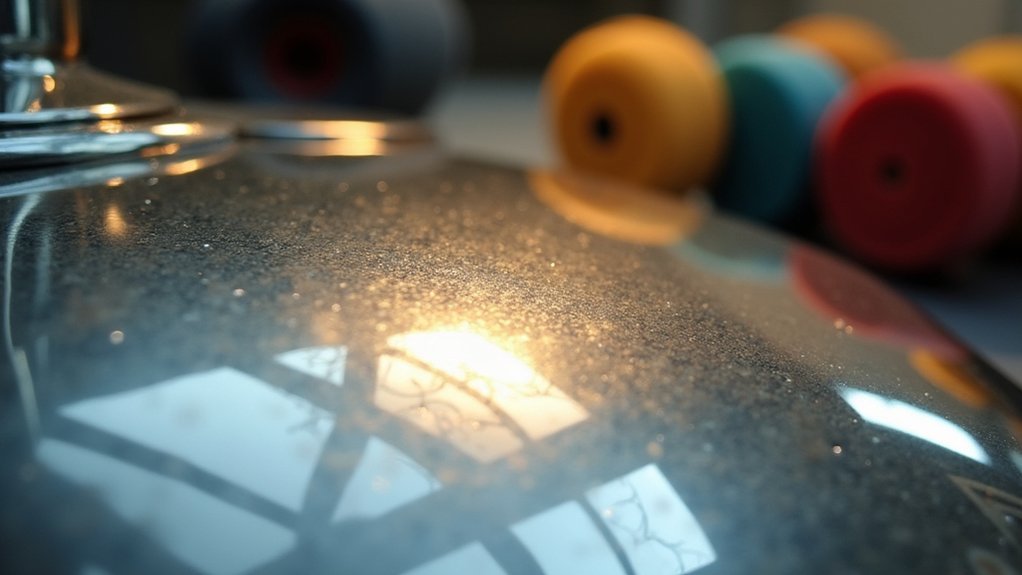
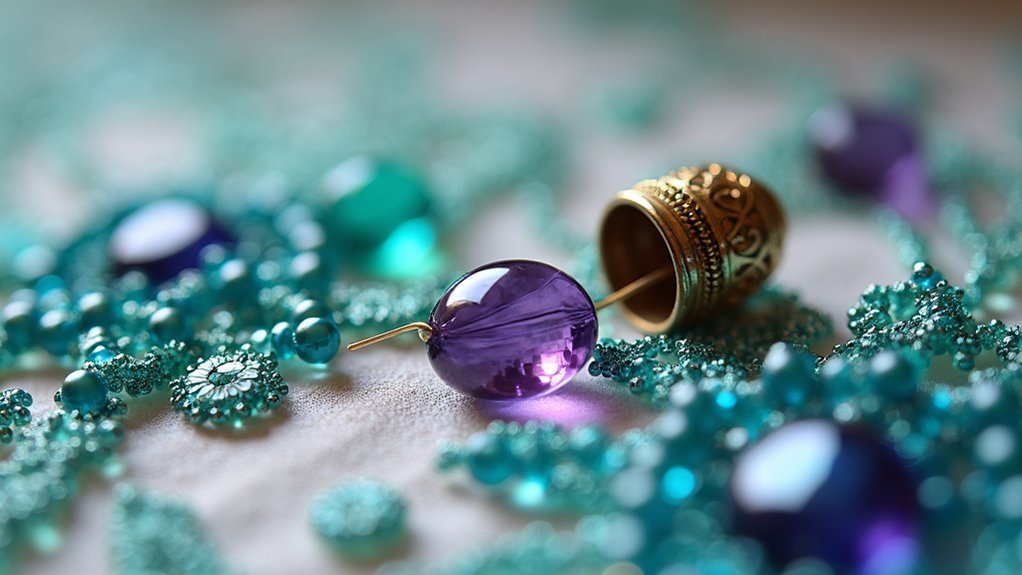

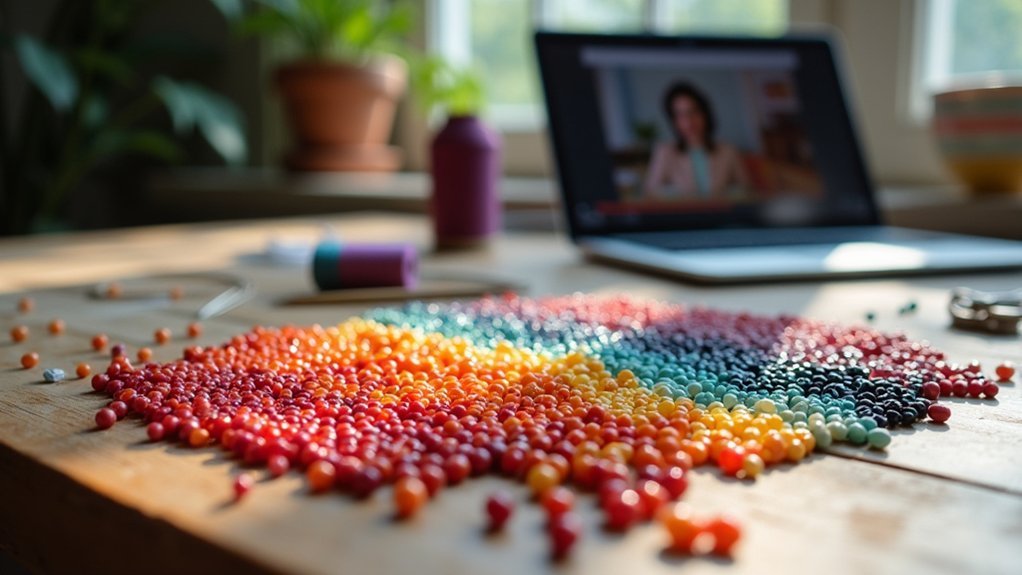
Leave a Reply